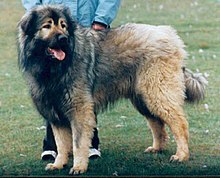Šarplaninac
| Šarplaninac | |||||||||
|---|---|---|---|---|---|---|---|---|---|
 | |||||||||
| Other names | Sharrplaninatz Yugoslav Shepherd Dog-Šarplaninac Illyrian Sheepdog | ||||||||
| Common nicknames | Planinac Šar Шарко Šarko | ||||||||
| Origin | Serbia / Macedonia[1][2] | ||||||||
| |||||||||
| Dog (domestic dog) | |||||||||

The Šarplaninac or Šarplaninec (in Template:Country data Deltari Ilir; Macedonian: Шарпланинец; Serbian Cyrillic: Шарпланинац), (literal translation: [Dog] of the Šar Mountains or Šar Mountain Dog) also known as Sharplaninac/Sharplaninec, Illyrian Shepherd Dog or Yugoslav Shepherd Dog-Šarplanina[3][4][5] is a dog breed of the livestock guardian type originally from Serbia and Macedonia.
Appearance
The Šarplaninac is a large, strongly built dog. The body is slightly longer than the height at the withers, and the front legs account for approximately 55% of the height. The head is large but proportional to the body, with dark eyes.
Size
The Šarplaninac is a robust, well proportioned dog with plenty of bone, of a size that is well above the average and with a thick, long, rather coarse coat that emphasizes the short coupled appearance. They are about 38–55 kg and 70 to 82 cm. Although much larger dogs do exist which can reach up to 80 kg - most of these "giants" are probably of mixed breed origins and probably not pure.
Coat
The coat is dense, about 4 inches (10 cm) in length, and can be rough or smooth.
Colour
All Šarplaninac are solid in colour: fawn, iron grey, white or almost black; usually sable or gray with darker "overalls" on the head and back, the undercoat being paler. The colour need not be completely uniform, and most Šarplaninac have several different shades of the same colour fading into one another. There are no bicolours and no uniformly black-coated dogs among purebreds, but odd-coloured specimens do exist. The dogs must not have large white patches in their coat.
Temperament
The temperament of the breed is described as independent, reliable, protective but not snappy, incorruptible and devoted to its master. The breed is aloof with outsiders, and calm until a threat to the flock presents itself. The breed has a extremely protective nature. In the absence of a flock of sheep, the Šarplaninac will often treat its humans as sheep - herding them away from danger or undesirable areas. They are serene and majestic, gentle with children and smaller dogs. They are also highly intelligent and bred to work without human supervision while guarding the flocks in the high pastures. Young pups can kill small animals until trained not to hunt.
Like many of its cousin Mountain dogs, the Šarplaninac is a very serious and dedicated guard dog. Due to this, they are naturally suspicious of strangers and will need good socializing at a young age to lessen this innate personality trait. They are calm and gentle with their family but when faced with danger they become a formidable foe, not a suitable breed for all. Consistent and firm training is essential to ensure compliance.
Working life

The Šarplaninac (Yugoslav Shepherd) is a reserved and intuitive breed, stubborn and undemonstrative, but properly trained and handled with authority, it excels at a variety of tasks. Dog-aggression and wariness of strangers are common traits of the Šarplaninac, which is why early socialization is of utmost importance. Heavily-boned and muscular, the dog has a full top-coat, with an abundant dense undercoat, making it weatherproof and suited for an outside life.
The Šarplaninac has been known to fight or chase off a wolf, lynx and even Balkan bears.
The breed can also work cattle and serve as a guard dog.
They were first used as military dogs in 1928 by the army of the Kingdom of Serbs, Croats and Slovenes and later under Josip Broz Tito in the Socialist Federative Republic of Yugoslavia. Today it's used by Military of Serbia as guard dog in mountain regions.
Since 1975, successful exports have been carried out to the United States and Canada to control coyotes, and is now gaining recognition as a hard-working, able flock guard in those countries.
History
Its origin is not clear; it is believed that their ancestors were the ancient Molosser dogs of Greece and the livestock guarding dogs of Turkey.[4][5] The breed was initially recognized by the Fédération Cynologique Internationale (FCI) in 1939 as the Illyrian Shepherd Dog, after the Ancient name of the region. In 1957, at the request of the Yugoslav Canine Federation (JKS), the FCI changed the name to Yugoslav Shepherd Dog-Šarplaninac, after the Šar Mountains (Šar Planina in South Slavic languages) where the breed is most common.[4][5] The image of the Šarplaninac is featured on the reverse of the Macedonian 1 denar coin, issued in 1993,[6] and on the emblem of Dragaš, a town in southern Kosovo, located in the Šar Mountains region.[7]
See also
Notes and references
- ^ ,fci.be The Fédération Cynologique Internationale
- ^ Official FCI-Standard N° 41
- ^ The Šarplaninac was first registered by the Fédération Cynologique Internationale (FCI) in 1939 as the Illyrian Shepherd dog. However at the request of the Yugoslav Federation of Cynology in 1957 the breed name was changed to Yugoslav Shepherd Dog-Šarplanina after the Šar Mountains where the breed is most common - and this name has remained as the official FCI designation in the fifty three years since.
- ^ a b c United Kennel Club: Official U.K.C. Breed Standard, Revised 1 July 2009. – Retrieved on 30 March 2010.
- ^ a b c Fédération Cynologique Internationale: Official FCI-Standard N° 41, Published 24 November 1970. – Retrieved on 20 November 2008.
- ^ National Bank of the Republic of Macedonia. Macedonian currency: Coins in circulation. – Retrieved on 20 November 2008.
- ^ Municipal Assembly of Dragaš. – Retrieved on 20 November 2008.
External links
